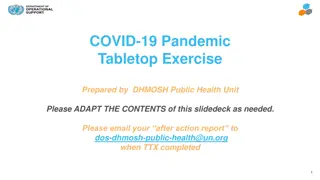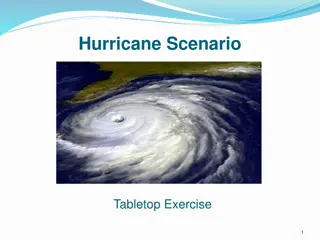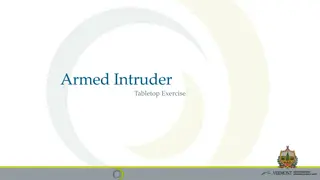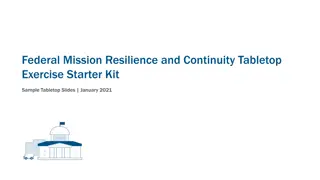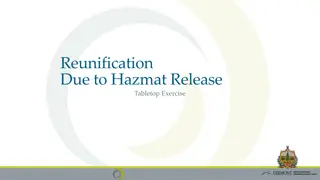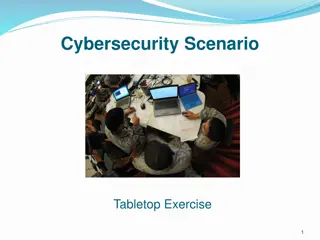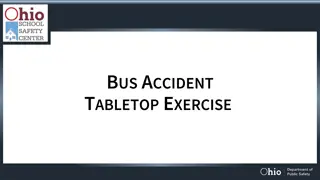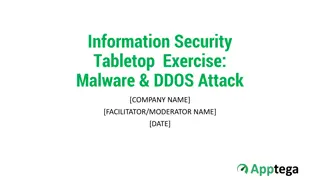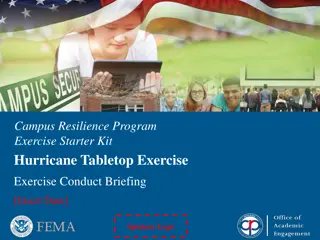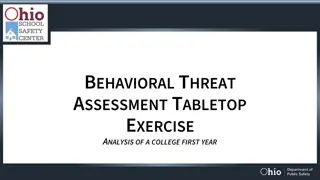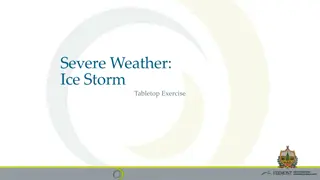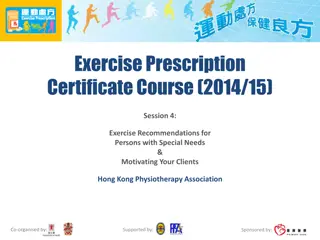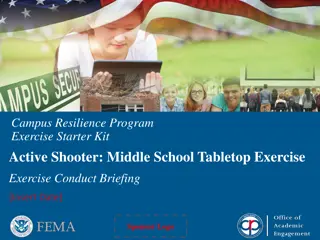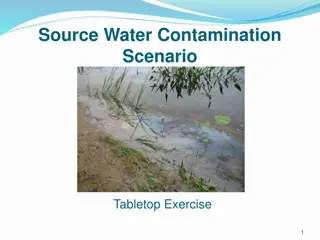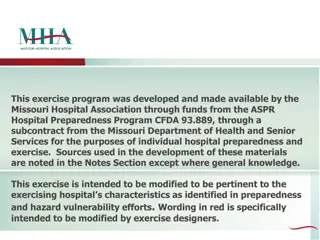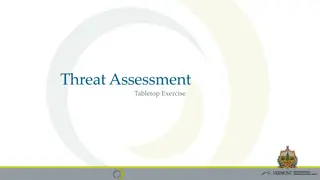Radiological Dispersion Device Tabletop Exercise Overview
This tabletop exercise focuses on simulating a radiological dispersion device scenario to enhance emergency response readiness and assess response plans. The exercise includes agenda discussions, administrative details review, scenario analysis, facilitated discussions, action planning sessions, and exercise benefits identification. Participants will refine roles and responsibilities for managing radiological incidents and stakeholder relationships.
Download Presentation

Please find below an Image/Link to download the presentation.
The content on the website is provided AS IS for your information and personal use only. It may not be sold, licensed, or shared on other websites without obtaining consent from the author. Download presentation by click this link. If you encounter any issues during the download, it is possible that the publisher has removed the file from their server.
E N D
Presentation Transcript
Radiological Dispersion Device Scenario Tabletop Exercise 1
Tabletop Exercise Welcome and introductions Discuss agenda for the day Review administrative details Start the exercise 2
Welcome and Introductions Name Organization Emergency response experience 3
Agenda Review exercise materials and rules Review scenario(s) Break Facilitated discussion period Action planning session ( hot wash ) Review and conclusion Closing comments 4
Administrative Details Location of emergency exits Location of restrooms Cell phone and pager management Logging your time to fulfill training requirements Sign-in sheet and participant evaluation form 5
Exercise Benefits: Increase readiness in the event of an actual emergency Provide a means to assess effectiveness of response plans and response capabilities Serve as a training tool for response personnel and their involvement with other response agencies Provide an opportunity to practice skills and improve individual performance in a non- threatening environment 6
Exercise Benefits: (cont.) Require participants to network with each other and pre-plan decisions on resources Identify planning conflicts or gaps Identify resource needs and opportunities for sharing of resources Clarify internal and external roles and responsibilities 7
Exercise Objectives: At the conclusion of this exercise, participants should be able to do the following: Define or refine participants roles and responsibilities for managing the consequences of a radiological dispersion device incident, which should be reflected in their plans, policies and procedures and other preparedness elements currently in place or under development Build relationships between utilities and stakeholders 8
Exercise Objectives: (cont.) Determine neighboring utility water infrastructure capabilities and needs Identify other needed enhancements related to training and exercises and other preparedness elements currently in place or under development This session will not be a success unless you as a participant go back to your office and follow through 9
Roles and Responsibilities: Players respond to the situation presented based on expert knowledge of response procedures, current plans and procedures and insights derived from training and experience Observers observe the exercise but do not participate in the facilitated discussion period Facilitators lead the exercise by presenting the scenario narrative and facilitating the discussion period and hot wash (Action planning session or review session) Evaluators monitor the exercise, track accomplishments according to objectives and may ask questions 10
Exercise Rules: This exercise will be held in an open, low-stress no- fault environment varying viewpoints, even disagreements, are expected Respond to the scenario using your knowledge of current plans and capabilities (i.e., you may use only existing assets) and insights derived from your training Decisions are not precedent setting and may not reflect your organization s final position on a given issue this exercise is an opportunity to discuss and present multiple options and possible solutions 11
Exercise Rules: (cont.) Issue identification is not as valuable as suggestions and recommended actions that could improve [prevention, protection, mitigation, response or recovery] efforts problem-solving efforts should be the focus Assume there will be cooperation and support from other responders and agencies The basis for discussion consists of the scenario narrative and modules, your experience, your understanding of your Emergency Response Plan (ERP), your intuition and other utility resources included as part of this material or that you brought with you Treat the scenario as if it will affect your area 12
Action Planning Session: Following the facilitated discussion period, the facilitator will lead an Action Planning Session, also known as a hot wash Participants are encouraged to identify, discuss and prioritize next steps, actions, tasks and other follow-up activities Identify additional collaborators if needed Schedule a follow-up meeting 13
Radiological Dispersion Device Scenario 14
Module 1 April 24 The Threat 15
Module 1 April 24,2000 hrs Tuesday evening s news reports that regional counterterrorism teams are active in the state A request is made for the public to be aware and notify authorities of persons exhibiting unusual behavior Late in the evening, the utility receives a call from the police department that a resident reported seeing an unusual vehicle parked near the utility fence line Police investigated, but no one was there 16
Key Issues Module 1 The drinking water facility is located near several other government buildings The sighting of suspicious persons or vehicles on utility property is uncommon 17
Module 2 April 25 The Radiological Dispersion Device Is Detonated 18
Module 2 April 25, 1200 hrs A loud, muffled explosion is heard that shakes the walls of the drinking water utility and other buildings in the area Sirens are heard coming from the same direction that the utility s storage tanks and reservoirs are located Soon after, both the drinking water and wastewater utilities are notified to attend an emergency meeting at the county s Emergency Operations Center (EOC) 19
Key Issues Module 2 No unusual smells or debris were noted near the drinking water facilities in the minutes following the explosion Utility workers observe traffic beginning to back up in the direction of the storage tanks and reservoirs 20
Module 3 April 25 Response Begins 21
Module 3 April 25, 1300 hrs At the EOC it is announced that terrorists detonated an improvised radiological dispersion device in the area of the drinking water reservoirs There is significant damage to other government buildings in that area, with two deaths reported Reports indicate that the explosion contained cesium 137, cobalt-60, cesium chloride and/or uranium dust State and federal response teams will be arriving, an evacuation is in process, the local EOC is fully activated and an Incident Command System (ICS) organization has been implemented 22
Module 3 April 25, 1300 hrs (cont.) Response team officials present a map of an air plume analysis and estimates of where wind will carry and deposit the radiological particulates and by what time The response team subject matter experts clarify that the air models can change, and field surveys have yet to confirm actual particulate amounts Some of the drinking water reservoirs are in the plume s path utility personnel begin reviewing the Water Contaminant Information Tool (WCIT) 23
Key Issues Module 3 The water utility representatives realize that two of the three main water reservoirs are covered tanks with open vents located within the area that will likely be affected by higher concentrations of radioactive particulates it is estimated that the water distribution system that draws from these tanks serves 10 percent of the customer population The water utility representatives also realize that the estimate indicates that three hours later, a less dangerous level of radioactive particulates might reach the water pump station that controls the intake from the raw water reservoirs utility personnel in the area may also become contaminated 24
Key Issues Module 3 (cont.) News media has made several uncorroborated broadcasts about the safety of the drinking water and the utility s call center is overwhelmed with calls from concerned customers The water utility representatives are unsure how long radiochemical water sample analyses will take and request HazMat and laboratory assistance The air plume analysis indicates that the wastewater plant is located outside the path of contaminants carried by wind however, wastewater utility representatives are concerned about receiving contaminated drinking water from potentially affected neighborhoods 25
Key Issues Module 3 (cont.) The state wastewater permitting authorities and hazardous material response team work together to calculate that if it rains as predicted, storm water runoff and drainage from the impacted areas served by a combined wastewater and storm water collection system may become highly contaminated and reach the wastewater plant within two days 26
Key Issues Module 3 (cont.) The level of radiation that might arrive at the wastewater plant via storm water is unknown, but is projected to contaminate the wastewater treatment plant systems as well as the activated sludge, water, biosolids and ambient air in and around the plant utility personnel may also be at risk to contamination and the entire facility may become uninhabitable The wastewater utility representatives are unsure how to arrange for continual radiological analyses of plant influent and effluent 27
Key Issues Module 3 (cont.) Drinking water utilities downstream from the wastewater utility are concerned and want to know what is being done to protect the river and their other water sources from contamination Additionally, water and wastewater utilities report that some personnel are requesting time off to evacuate their families and are concerned about the health risks of reporting for work 28
Action Planning Session Post-Exercise Hot Wash 29
Review of Exercise Objectives Explore and address cybersecurity challenges Define or refine participants roles and responsibilities for managing the consequences of a cybersecurity incident, which should be reflected in their plans, policies and procedures and other preparedness elements currently in place or under development Build relationships between utilities and stakeholders Increase awareness of the damage that can be caused by a cybersecurity incident on a business or control system Identify other needed enhancements related to training and exercises and other preparedness elements currently in place or under development 30
Conclusion Please turn in your notes from the Action Planning Session, your participant evaluation form and any additional comments you wish to share This information will be used to develop an After Action Report and Improvement Plan 31
Closing Remarks Thank you for participating 32




